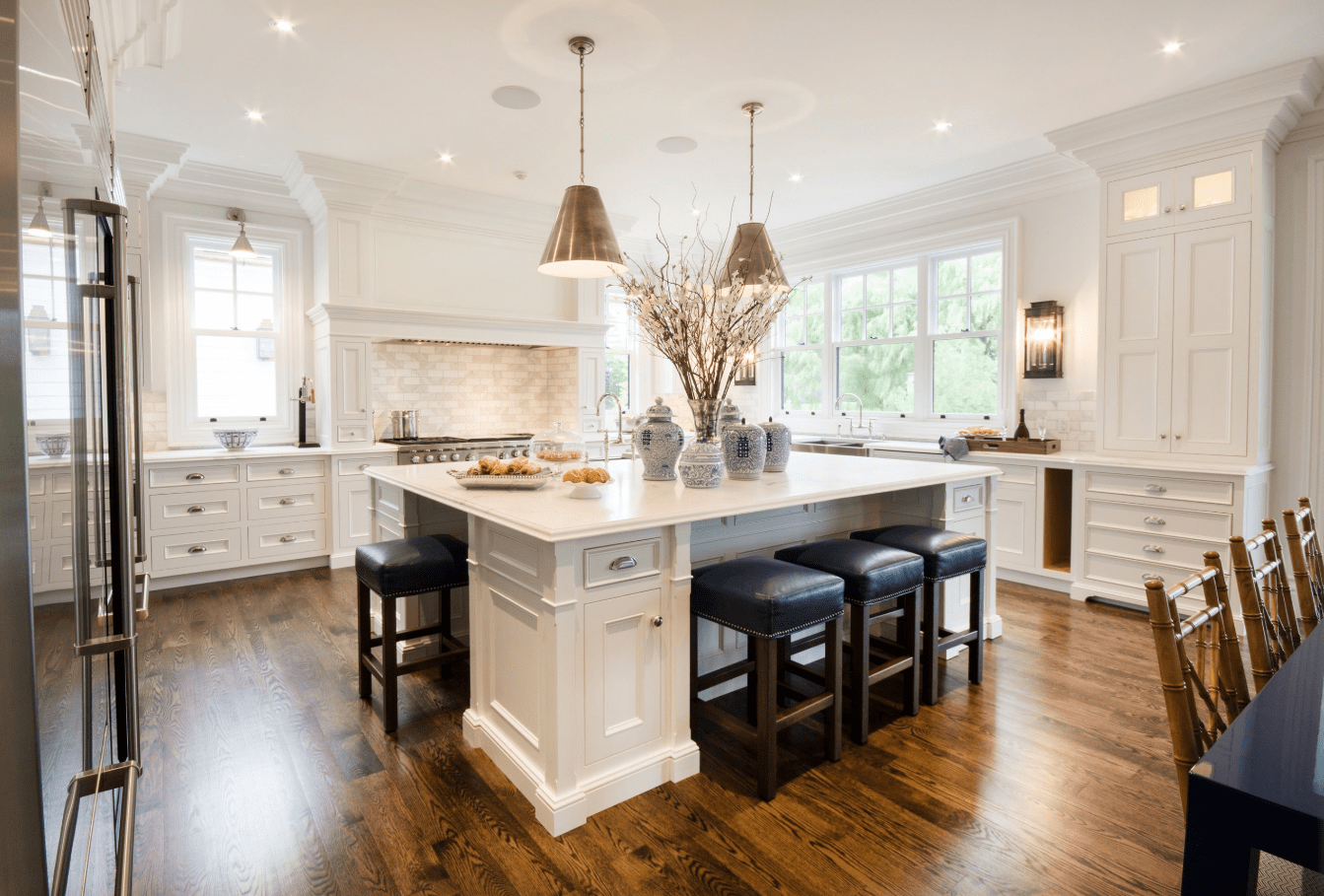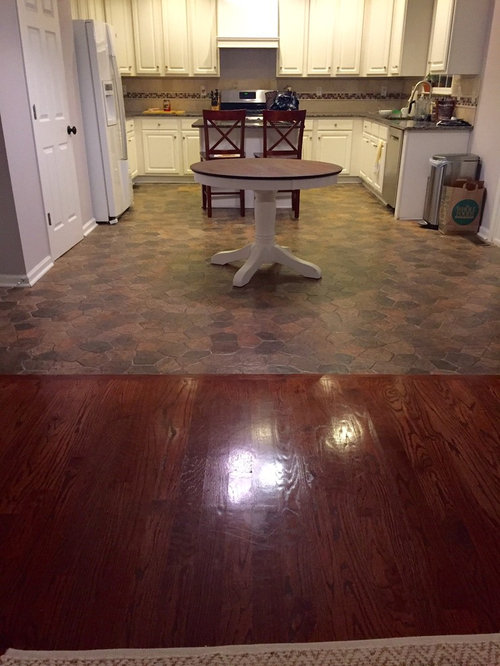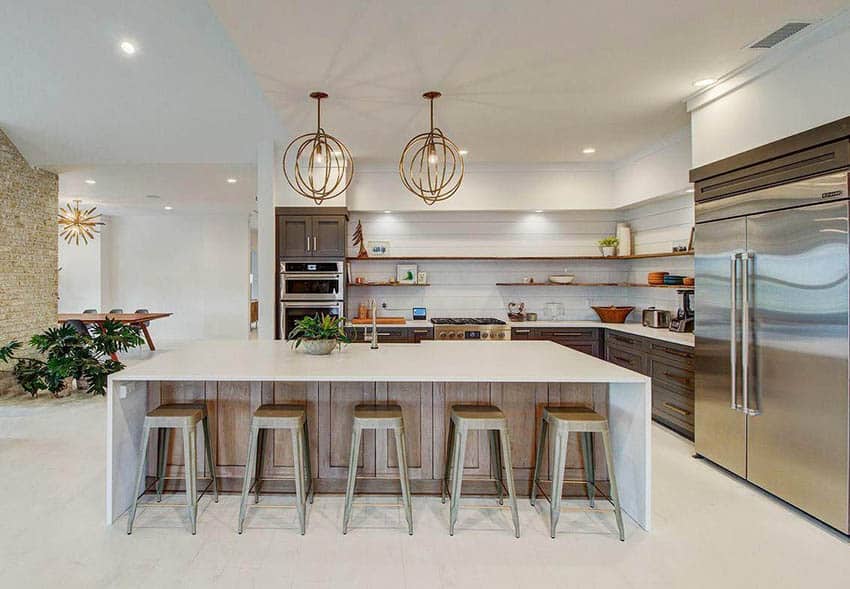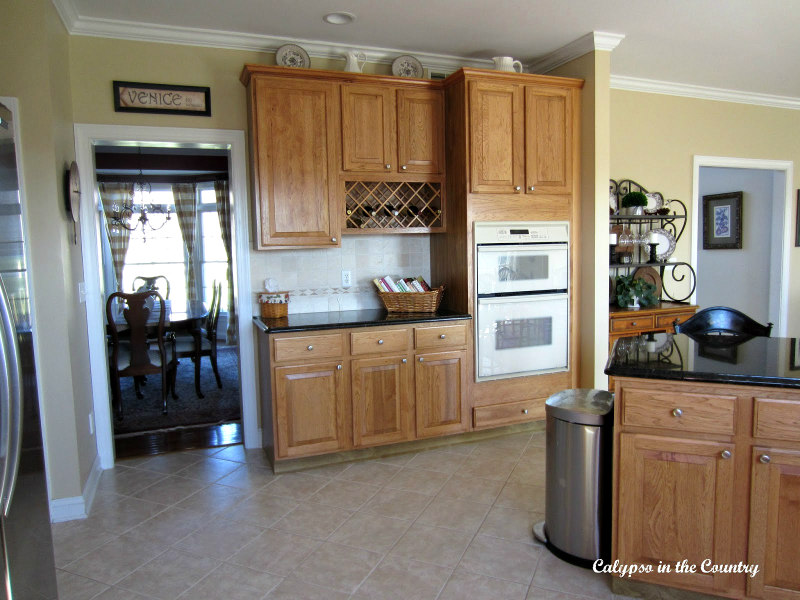Aesthetics Comparison
When it comes to kitchen flooring, aesthetics play a crucial role in creating a visually pleasing and inviting space. Hardwood floors and tile are two popular choices that offer distinct visual appeal. We will compare the aesthetics of hardwood floors and tile in kitchen spaces, exploring their unique characteristics and the impact they have on the overall design.
- Hardwood Floors: Hardwood floors bring warmth and elegance to any kitchen space. The natural grain patterns and rich tones of hardwood add a touch of timeless beauty. Whether you choose oak, maple, or walnut, hardwood floors provide a classic and sophisticated look that complements various kitchen styles, from traditional to modern. The smooth surface of hardwood creates a seamless and cohesive appearance, making the kitchen feel spacious and inviting.
- Tile: Tile flooring offers endless possibilities for creativity and customization. With a wide range of colors, patterns, and textures available, tile allows homeowners to achieve a unique and personalized look. From sleek and contemporary to rustic and traditional, there is a tile design to suit every kitchen style. Additionally, tile can mimic the look of natural materials like wood or stone, providing a cost-effective alternative without compromising aesthetics.
- Comparing Aesthetics: When comparing the aesthetics of hardwood floors and tile in kitchen spaces, it ultimately comes down to personal preference and the desired style of the kitchen. Hardwood floors exude warmth and sophistication, creating a timeless appeal that can enhance the overall value of the space. On the other hand, tile offers versatility and the opportunity to create bold and eye-catching designs, making a statement in the kitchen.
- Cohesion with Cabinetry and Countertops: Another factor to consider when comparing aesthetics is the cohesion between the flooring, cabinetry, and countertops. Hardwood floors can create a seamless transition and harmonize with wooden cabinetry, providing a cohesive and elegant look. Tile, on the other hand, allows for more contrast and can complement various countertop materials like granite or quartz, creating an interesting visual interplay.
- Maintenance Considerations: While aesthetics are important, it is crucial to consider the maintenance requirements of both hardwood floors and tile in kitchen spaces. Hardwood floors require regular cleaning and occasional refinishing to maintain their beauty. On the other hand, tile is relatively low maintenance, with routine cleaning being sufficient to keep it looking its best. Considering the long-term maintenance commitment can help homeowners make an informed decision regarding the aesthetics of their kitchen flooring.
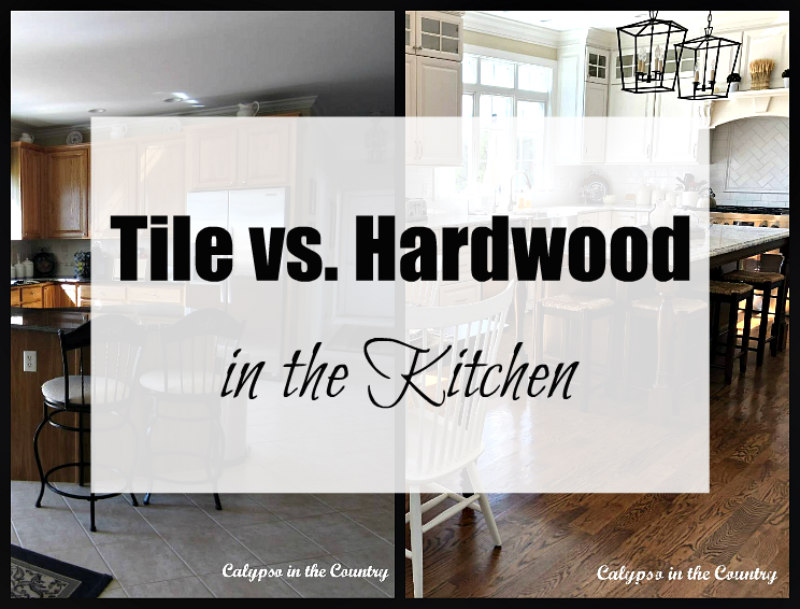
Durability and Maintenance
When it comes to kitchen flooring, durability, and maintenance are essential factors to consider. The kitchen is a high-traffic area prone to spills, stains, and heavy foot traffic, so it’s important to choose a flooring option that can withstand the demands of daily use. We will analyze the durability and maintenance requirements of hardwood floors and tile in kitchens, helping homeowners make informed decisions based on their needs and lifestyles.
Hardwood Floors: Hardwood floors are known for their durability and longevity. When properly maintained, hardwood flooring can last for decades. However, it is important to note that hardwood is susceptible to scratches and dents, especially in high-traffic areas. To mitigate this, homeowners can choose harder wood species like oak or hickory, which are more resistant to wear and tear. Regular maintenance includes sweeping or vacuuming to remove dirt and debris, and occasional refinishing to restore the shine and protect the wood.
Tile: Tile flooring is highly durable and can withstand heavy use without showing signs of wear. It is resistant to scratches, stains, and moisture, making it an excellent choice for kitchens. Ceramic or porcelain tiles are commonly used in kitchen spaces due to their durability and ease of maintenance. Routine cleaning involves sweeping or mopping to remove dirt and spills. In the event of cracked or damaged tiles, individual tiles can be easily replaced without affecting the entire floor.
Comparing Durability: In terms of durability, tile flooring has an edge over hardwood floors. Tiles are resistant to scratches, stains, and moisture, making them a practical option for busy kitchens. Hardwood floors, although durable, require more care to prevent scratches and maintain their appearance. However, with proper maintenance and care, hardwood floors can withstand the demands of a kitchen environment.
Maintenance Considerations: When it comes to maintenance, both hardwood floors and tile require regular cleaning. Hardwood floors should be swept or vacuumed to remove dirt and debris, and spills should be promptly wiped clean to prevent stains. Periodic refinishing may be needed to restore the protective layer and maintain the wood’s appearance. On the other hand, tile floors only require routine sweeping or mopping to keep them clean. Grout lines may require occasional cleaning and sealing to prevent staining or discoloration.
Lifestyle Factors: The choice between hardwood floors and tile in terms of durability and maintenance can also be influenced by lifestyle factors. If you have children or pets, tile flooring may be more suitable as it is more resistant to scratches and stains. However, if you prefer the warmth and natural beauty of hardwood, there are ways to mitigate potential damage, such as using area rugs in high-traffic areas or applying protective coatings.
Comfort and Sound
In addition to aesthetics and durability, the level of comfort and sound absorption provided by kitchen flooring is an important consideration. The kitchen is often a gathering place for family and friends, so it’s essential to choose a flooring option that offers comfort and minimizes noise. We will evaluate the level of comfort and sound absorption provided by hardwood floors and tile in kitchen areas, helping homeowners create a comfortable and inviting space.
Hardwood Floors: Hardwood floors provide a natural warmth and comfort underfoot. The solid wood construction offers a slight give, resulting in a more comfortable surface to stand on for extended periods. This can be particularly beneficial for those who spend a significant amount of time cooking or working in the kitchen. However, hardwood floors do not provide much sound absorption, which can result in more noise transmission, especially in open-concept kitchen spaces.
Tile: Tile flooring, particularly when installed with proper underlayment, can offer some level of comfort and cushioning. However, it is generally a harder surface compared to hardwood. Standing on the tile for long periods may cause discomfort or fatigue, especially for individuals with joint issues. On the positive side, tile floors can help dampen noise to some extent, reducing the sound transmission caused by footsteps or dropped objects. This can be advantageous for those seeking a quieter kitchen environment.
Comparing Comfort and Sound Absorption: When comparing the comfort and sound absorption of hardwood floors and tile in kitchen areas, it’s important to consider personal preferences and individual needs. Hardwood floors provide a more comfortable surface to stand on, which can be beneficial for those who spend a lot of time in the kitchen. However, tile floors offer better sound absorption, creating a quieter environment, particularly in open-concept spaces where noise can easily travel.
Additional Comfort Considerations: To enhance the comfort level of hardwood floors, homeowners can use area rugs or mats in high-traffic areas, such as near the sink or stove. These not only provide additional cushioning but also add a decorative element to the kitchen. Similarly, for tile floors, using anti-fatigue mats in areas where prolonged standing is common can alleviate discomfort and reduce fatigue.
Soundproofing Solutions: If noise reduction is a significant concern, there are additional soundproofing solutions that can be applied to enhance the acoustics in the kitchen. For hardwood floors, installing an acoustic underlayment beneath the flooring can help reduce noise transmission. For tile floors, using sound-absorbing materials in the subfloor or selecting thicker and dense tiles can also contribute to better soundproofing.
Cost and Installation
When considering kitchen flooring options, cost and installation are important factors to take into account. The budget for your kitchen renovation and the complexity of the installation process can greatly influence your decision. Let’s discuss the financial considerations and installation processes involved in choosing between hardwood floors and tile for kitchens, helping homeowners make an informed decision based on their budget and preferences.
Cost of Hardwood Floors: Hardwood flooring is often considered a premium option and tends to have a higher upfront cost compared to other materials. The price of hardwood floors can vary depending on factors such as the type of wood, grade, and finish. Exotic hardwood species, such as Brazilian cherry or teak, can be more expensive than domestic options like oak or maple. Additionally, the cost may increase if you opt for wider planks or specialty finishes. It is important to factor in the cost of installation, which may require professional expertise.
Cost of Tile: Tile flooring offers a wide range of price options, making it suitable for various budgets. The cost of tile can vary depending on factors such as the type of tile (ceramic, porcelain, natural stone), the size of the tiles, and the complexity of the design. Ceramic tiles are generally more affordable compared to porcelain or natural stone options. Additionally, the cost of installation should be considered, including factors such as subfloor preparation, adhesive, grout, and labor.
Installation Process for Hardwood Floors: The installation of hardwood floors typically involves several steps. First, the existing flooring may need to be removed and the subfloor prepared. Then, the hardwood planks are installed by either nailing them down or gluing them to the subfloor. Depending on the chosen installation method, additional steps such as sanding, staining, and sealing may be required. It is recommended to hire a professional installer for hardwood flooring to ensure proper installation and to avoid costly mistakes.
Installation Process for Tile: The installation process for tile flooring can vary depending on the type of tile and the desired design. Generally, it involves preparing the subfloor, applying adhesive, and laying the tiles in the desired pattern. Grout is then applied to fill the gaps between the tiles. The complexity of the installation can increase if intricate designs or special cuts are required. While it is possible to undertake a tile installation as a DIY project, hiring a professional installer is advisable for more complex designs or if you lack experience.
Cost vs. Value: When considering the cost of hardwood floors and tile, it is important to also consider the long-term value they bring to your home. Hardwood floors are often seen as an investment that can increase the resale value of a property. They have timeless appeal and can attract potential buyers. On the other hand, tile flooring also offers durability and a wide range of design options, which can enhance the overall value and appeal of your kitchen space.
Resale Value
When it comes to home renovations, considering the impact on resale value is often a top priority for homeowners. The choice of flooring in the kitchen can significantly affect the overall appeal and value of a home. We will discuss the impact of hardwood floors and tile on the resale value of a home, specifically in the kitchen context, helping homeowners make an informed decision that can potentially maximize their return on investment.
Hardwood Floors and Resale Value: Hardwood floors are widely regarded as a desirable feature in a home. They have a timeless and classic appeal that can attract potential buyers. Hardwood floors in the kitchen can create a cohesive and visually appealing space, enhancing the overall aesthetics of the home. The durability and longevity of hardwood floors also contribute to their value, as they are seen as a long-term investment. Homebuyers often perceive hardwood floors as a high-quality and upscale feature, which can positively impact the resale value of a home.
Tile Flooring and Resale Value: Tile flooring, particularly in the kitchen, can also have a positive impact on the resale value of a home. The wide range of design options available with tile allows homeowners to create unique and visually striking kitchen spaces. Ceramic or porcelain tiles are durable and resistant to stains, making them attractive to potential buyers. Additionally, tile floors are often associated with cleanliness and ease of maintenance, further adding to their appeal. A well-designed and properly installed tile floor can contribute to the overall value and marketability of a home.
Market Trends and Buyer Preferences: When considering the impact of hardwood floors and tiles on resale value, it is essential to take into account market trends and buyer preferences. Regional preferences and current design trends can influence the desirability of certain flooring options. It is advisable to research local real estate markets and consult with a real estate professional to understand the preferences of potential buyers in your area. This information can help guide your decision and ensure that you choose a flooring option that aligns with market demand.
Maintenance Considerations: Another factor to consider is the maintenance requirements of hardwood floors and tiles. Hardwood floors may require occasional refinishing to maintain their appearance, while tile floors generally require routine cleaning. Homebuyers may appreciate the low maintenance aspect of tile flooring, as it can be seen as a convenient and practical choice. However, well-maintained hardwood floors can also be appealing, as they offer a natural and warm aesthetic that can be difficult to replicate with other flooring materials.
Overall Impact: In conclusion, both hardwood floors and tile can have a positive impact on the resale value of a home, particularly in the kitchen. Hardwood floors are often perceived as a premium feature that adds value and appeal. Tile flooring offers design versatility, durability, and ease of maintenance, which can also contribute to the overall value of a home. Considering market trends, buyer preferences, and maintenance requirements can help homeowners make an informed decision that maximizes the resale value of their home.
Kitchen Flooring: Hardwood vs Tile vs Luxury Vinyl
THE BEST KITCHEN FLOOR: TILE VS HARDWOOD
Tiles Vs Hardwood for your Kitchen
Tile vs Hardwood in the Kitchen (Pros & Cons) – Designing Idea
Tile vs. Hardwood Floors in the Kitchen – Calypso in the Country
THE BEST KITCHEN FLOOR: TILE VS HARDWOOD
Hardwood vs Porcelain Tile – Best Kitchen Flooring Decision
Related Posts:
